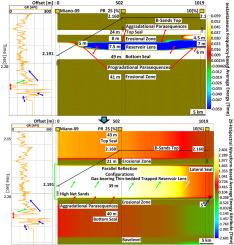Tectonically-subsidized shallow-marine Cretaceous gas-bearing stratigraphic traps, shelf-slope basin, NW-Arabian Sea: Seismic attributes and broadband porosity-constrained seismic acoustic impedance variability dynamical reservoir simulations
IF 4.1
3区 地球科学
Q2 GEOSCIENCES, MULTIDISCIPLINARY
引用次数: 0
Abstract
Quantitative inverted reservoir simulations-based seismic reservoir characterizations facilitate accurate imaging of stratigraphic traps, e.g., incised-valleys infills (IVFs) of Lowstands systems tract (LST). These systems are sourced by fluvial channel sandstone bodies (CH) and meandering point bars (PBARS), which are developed during sea-level standstill along the parallel (P) and divergent (D) seismic reflection configurations (SRF). From the well control points, poor frequency seismic and well logs create hurdles to quantifying the seismic stratigraphic and sedimentological constraints. These constraints are comprised of lithology-impedance contrasts for paleo-erosional and depositional sediments, paleo-dense fracture networks, inclination of stratigraphic traps, and lateral changes in thicknesses of thin-bedded prograding parasequence sets (PPS) and aggrading parasequence sets (APS). Accurate prediction of these constraints may lead to locating direct hydrocarbon indicators (DHI). During the development of IVFs, there are also varieties of SRFs, which serve as the key constituents for developing petroleum. These SRFs are not resolvable at the full-spectrum seismic due to sub-seismic deficiency of poor seismic frequency resolution. These full-spectrum seismic provide poor indicators for sources of sedimentary influxes, which are restricted to predicting source-reservoir and basins' configurations. These implications are not feasible to predict using full-spectrum seismic and well-log data due to the poor resolution of subsurface systems. Consequently, this study utilizes state-of-the-art 29 Hz average energy waveforms and broadband porosity-constrained seismic acoustic impedance variability dynamical reservoir simulations to quantify the Cretaceous system of Northwest Onshore, Arabian Sea. The 29 Hz waveform could image 15–18 m thick sandstone-filled channels inside IVFs. However, this attribute failed to predict the pore spaces due to tuning effects. Average energy-based dynamical simulations at (R) 2 = 0.73 have simulated 24–62 m thick depositional and 17–18 m thick erosional facies from 25 % seismic-based porosities (Ps). ∼ 45 m thick en-echelon architecture was also resolved and simulated by dynamical simulations at 10 % Ps inside the IVFs. Yet, the 29 Hz waveform-based dynamical simulations show unique seismic stratigraphic and sedimentological expressions of IVFs. This simulation has also simulated lateral changes in the lithology-impedance contrasts from PPS-APS, which indicates that P was a key component for gas generation at the continental shelf of the basin. A 39 m thick P gas-bearing thin-bed trapped CH lens was simulated at 25 % Ps. 25 % Ps also simulated a 21 m thick erosional zone D along the shelf-to-slope location. A continuous shoreline trajectory was simulated along this trapped lens inside dense-fractured networks. This trajectory has generated strong lateral lithology-impedance contrasts for APS-to-PPS along the shelf-to-slope basin. The inclination of the deposited trapped lens was <1° with a low-gradient and high-sinuosity index (S.I) of 2.2. This 2.2 high S.I. implicates the PBARS being the key source of sedimentary influxes for the IVF stratigraphic trap. APS with 0.938–1.094 dB's spectral amplitudes implicate highly-fractured sedimentary facies, and hence, the development of tectonic subsidence. These stratigraphic reservoir architectures have simulated 51 to 52 m-thick regionally developed gas-bearing pore spaces, which serve as DHIs along shelf-to-slope basins. Consequently, this research endeavours have vital tectonics-stratigraphic implications, which may serve as an analogue for global extension basins.

西北阿拉伯海陆架斜坡盆地白垩系浅海含气地层圈闭:地震属性和宽带孔隙度约束下的地震声阻抗变异性动态储层模拟
基于定量倒置储层模拟的地震储层表征有助于准确成像地层圈闭,例如低水位体系域(LST)的切谷充填体(IVFs)。这些系统的来源是在海平面静止期间沿平行(P)和发散(D)地震反射构型(SRF)发育的河道砂岩体(CH)和曲流点坝(PBARS)。从井控制点来看,低频地震和测井曲线给量化地震地层和沉积学限制带来了障碍。这些约束条件包括古侵蚀和沉积沉积物的岩性阻抗对比、古致密裂缝网络、地层圈闭的倾角以及薄层进积副层序集(PPS)和沉积副层序集(APS)厚度的横向变化。对这些约束条件的准确预测有助于确定直接油气指标(DHI)。在体外试管燃料的开发过程中,还出现了多种srf,它们是开发石油的关键成分。由于地震频率分辨率较差的次地震缺陷,这些srf在全谱地震中无法分辨。这些全谱地震对沉积流体来源的指示较差,仅限于对源储和盆地构型的预测。由于地下系统的分辨率较差,因此使用全谱地震和测井数据进行预测是不可行的。因此,本研究利用最先进的29 Hz平均能量波形和宽带孔隙度约束地震声阻抗变异性动态储层模拟来量化阿拉伯海西北陆上白垩纪体系。29hz波形可以成像试管内15-18 m厚的砂岩填充通道。然而,由于调谐效应,该属性无法预测孔隙空间。在(R) 2 = 0.73处,基于平均能量的动力学模拟模拟了24-62 m厚的沉积相和17-18 m厚的侵蚀相,这些沉积相来自25%的地震孔隙度(Ps)。通过在试管内10% Ps的动态模拟,也对~ 45 m厚的雁列结构进行了解析和模拟。然而,基于29 Hz波形的动力学模拟显示了ivf独特的地震地层学和沉积学表达。该模拟还模拟了PPS-APS岩性阻抗对比的横向变化,表明P是盆地大陆架天然气生成的关键组分。在25% Ps处模拟了一个39 m厚含P气的薄层捕获CH透镜体,25% Ps还模拟了沿陆架-斜坡位置的21 m厚侵蚀带D。沿着密集裂缝网络内的捕获透镜模拟了连续的海岸线轨迹。这条轨迹为大陆架-斜坡盆地的aps - pps形成了强烈的横向岩性阻抗对比。沉积的捕获透镜倾角为<;1°,低梯度,高弯曲指数(S.I)为2.2。2.2的高si值表明pbar是IVF地层圈闭的主要沉积流体来源。谱幅值为0.938 ~ 1.094 dB的APS反映了高度断裂的沉积相,反映了构造沉降的发育。这些地层储层构型模拟了51 ~ 52 m厚的区域性发育的含气孔隙空间,这些孔隙空间作为陆架-斜坡盆地的dhe。因此,这项研究工作具有重要的构造地层学意义,可以作为全球伸展盆地的类比。
本文章由计算机程序翻译,如有差异,请以英文原文为准。
求助全文
约1分钟内获得全文
求助全文
来源期刊

Physics and Chemistry of the Earth
地学-地球科学综合
CiteScore
5.40
自引率
2.70%
发文量
176
审稿时长
31.6 weeks
期刊介绍:
Physics and Chemistry of the Earth is an international interdisciplinary journal for the rapid publication of collections of refereed communications in separate thematic issues, either stemming from scientific meetings, or, especially compiled for the occasion. There is no restriction on the length of articles published in the journal. Physics and Chemistry of the Earth incorporates the separate Parts A, B and C which existed until the end of 2001.
Please note: the Editors are unable to consider submissions that are not invited or linked to a thematic issue. Please do not submit unsolicited papers.
The journal covers the following subject areas:
-Solid Earth and Geodesy:
(geology, geochemistry, tectonophysics, seismology, volcanology, palaeomagnetism and rock magnetism, electromagnetism and potential fields, marine and environmental geosciences as well as geodesy).
-Hydrology, Oceans and Atmosphere:
(hydrology and water resources research, engineering and management, oceanography and oceanic chemistry, shelf, sea, lake and river sciences, meteorology and atmospheric sciences incl. chemistry as well as climatology and glaciology).
-Solar-Terrestrial and Planetary Science:
(solar, heliospheric and solar-planetary sciences, geology, geophysics and atmospheric sciences of planets, satellites and small bodies as well as cosmochemistry and exobiology).
 求助内容:
求助内容: 应助结果提醒方式:
应助结果提醒方式:


